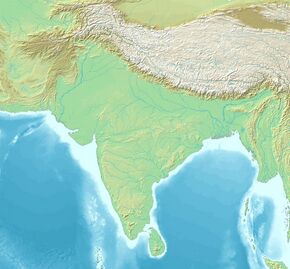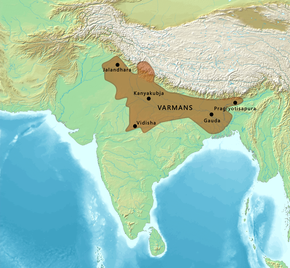History:Varman dynasty of Kannauj
Varman dynasty of Kannauj | |||||||||||||||||
|---|---|---|---|---|---|---|---|---|---|---|---|---|---|---|---|---|---|
| mid 7th century–c. 770 CE | |||||||||||||||||
Possible coinage of Yashovarman.[1]
Obverse: abstract Kushan-style king standing, Kidara monogram to inner right. Reverse: Abstract Ardoxsho seated facing, Brahmi script legend “Sri Yasova” to right, “rma” to left. | |||||||||||||||||
Map of the Varman territory at the time of Yashovarman, circa 700 CE.[2] | |||||||||||||||||
| Capital | Kannauj | ||||||||||||||||
| Common languages | Sanskrit | ||||||||||||||||
| Religion | Hinduism Jainism | ||||||||||||||||
| Government | monarchy | ||||||||||||||||
| History | |||||||||||||||||
• Established | mid 7th century | ||||||||||||||||
• Disestablished | c. 770 CE | ||||||||||||||||
| |||||||||||||||||
| Today part of | India | ||||||||||||||||
The Varman dynasty of Kannauj was a dynasty that ruled Kannauj and the surrounding areas from the mid 7th century to the late 8th century.[3] It was founded by Yashovarman, who filled the power vacuum created after emperor Harshavardhana's death.
History
Establishment
The city of Kannauj had previously been ruled by emperor Harshavardhana, who died without an heir and thus created a power vacuum. This lasted for around a century before Yashovarman emerged as its ruler.[4] Alexander Cunningham, an archaeologist of the British Raj period, speculated on possible rulers of Kannauj during the period between Harsha and Yashovarman but there is little evidence to support his claims.[5] Much of information on him is derived from the Gaudavaho (Slaying of the king of Gauda),[6] a Prakrit-language poem written by his court poet Vakpati. According to the Jain chronicles, Yashovarman had a son named Āma, who succeeded him as the king of Kannauj during 749-753 CE.[7][8]
Expansion
The dynasty reached its greatest extent and zenith of prosperity only under its founder, Yashovarman. The Gaudavaho depicts Yashovarman as conquering large swathes of northern India — including Bihar, Bengal, the western Deccan, Indus Valley and Kashmir — before returning in triumph to Kannauj. However, Kalhana, a Kashmiri court chronicler who lived around the 12th century CE, gives a very different story in his Rajatarangini, depicting Yashovarman as a ruler who was among those defeated by Lalitaditya Muktapida, a very powerful Karkota ruler of Kashmir.[9]
Although R. C. Majumdar is among those who are wary of the ancient accounts of conquests, he believes that Yashovarman was "unquestionably the most powerful king [in the region] about this time."
Decline
Yashovarman's successors did not expand the kingdom and were all weak kings, who did not pay much attention to administration. They are considered as unsuccessful rulers.[10] Āma, Dunduka, and Bhoja are considered as insignificant rulers, who achieved nothing of importance and reigned for 15–20 years.[11] The last king, Bhoja was probably defeated by the Ayudhas, who established a new dynasty.[11]
List of rulers
- Suryavarman (c. 710-725 CE), whose daughter Vasati married the Panduvamshi king Harshagupta of Dakshina Kosala.
- Yashovarman (c. 725–752 CE), founder of dynasty
- Āma
- Dunduka
- Bhoja (ruled till 770 CE), last ruler of dynasty
References
- ↑ Cribb, Joe (April 2017). "Early Medieval Kashmir Coinage – A New Hoard and An Anomaly" (in en). Numismatic Digest 40: 110. https://www.academia.edu/32663187.
- ↑ Schwartzberg, Joseph E. (1978). A Historical atlas of South Asia. Chicago: University of Chicago Press. p. 146, map XIV.2 (e). ISBN 0226742210. https://dsal.uchicago.edu/reference/schwartzberg/pager.html?object=183.
- ↑ Map of the territory of the Varman dynasty in Schwartzberg, Joseph E. (1978). A Historical atlas of South Asia. Chicago: University of Chicago Press. p. 146, map XIV.2 (e). ISBN 0226742210. https://dsal.uchicago.edu/reference/schwartzberg/pager.html?object=183.
- ↑ Chopra (2003), p. 194
- ↑ Tripathi (1989), p. 192
- ↑ Majumdar (2003), p. 259
- ↑ Mishra 1977, p. 117.
- ↑ Mishra 1977, p. 125.
- ↑ Eraly (2011), pp. 92–93, 622
- ↑ Rama Shankar Tripathi (1964). History of Kanauj: To the Moslem Conquest. Motilal Banarsidass. p. 211 ISBN:978-81-208-0478-4
- ↑ 11.0 11.1 Sen, Sailendra Nath (1999). Ancient Indian History and Civilization (Paperback ed.). New Age International. pp. 264–668. ISBN 9788122411980. https://books.google.com/books?id=Wk4_ICH_g1EC&pg=PA246.
 |
![Possible coinage of Yashovarman.[1] Obverse: abstract Kushan-style king standing, Kidara monogram to inner right. Reverse: Abstract Ardoxsho seated facing, Brahmi script legend “Sri Yasova” to right, “rma” to left. of Varman dynasty of Kannauj](/wiki/images/thumb/1/13/Coinage_of_Yasovarman.jpg/270px-Coinage_of_Yasovarman.jpg)



